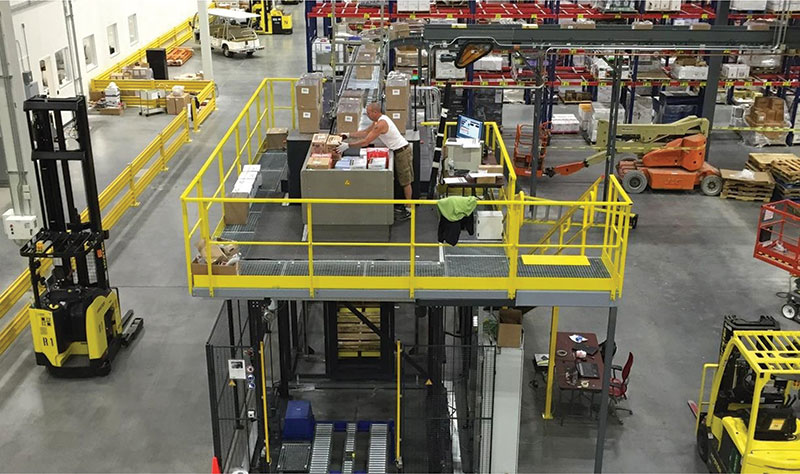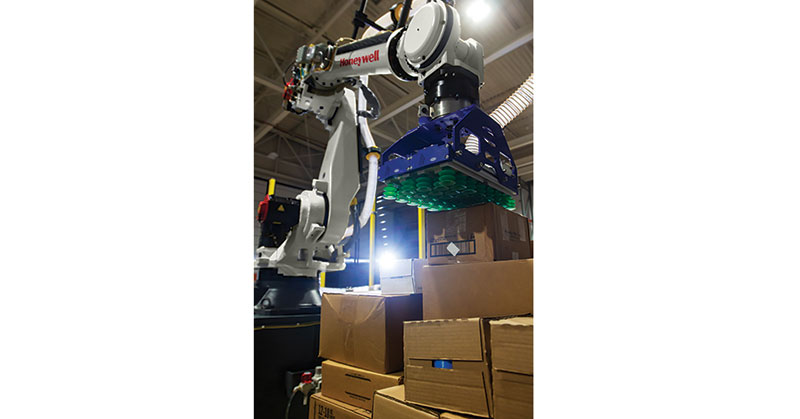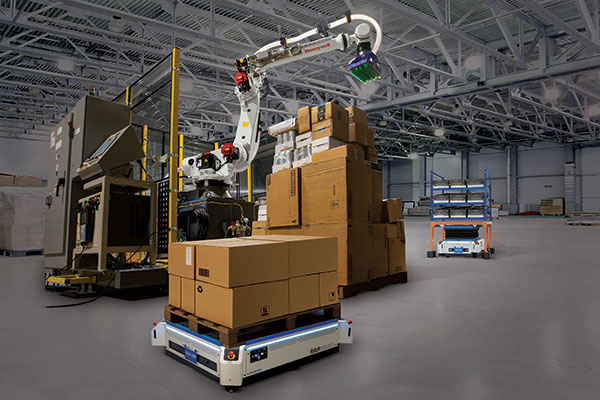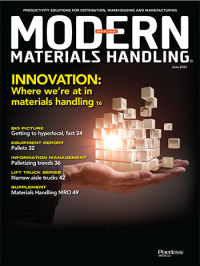Palletizing: 4 trends that boost flexibility
Automated palletizing systems are proven solutions, and they are becoming more flexible in accommodating different SKUs and tasks. Vendors are giving operations plenty of choice, putting more emphasis on software capabilities and ease of use.
Warehouses that focus on fulfilling consumer e-commerce orders are rightly concerned about automation that brings efficiency to the picking and packing of each-level items for e-commerce fulfillment. But, for many DCs, the process of palletizing remains among the most labor-intensive tasks.
Not only can automated palletizing increase throughput while shaving costs, it also eliminates one of the most physically demanding manual tasks in a DC, allowing operations to spread precious labor resources elsewhere.
“The ergonomics and the staffing factors are big drivers for automated palletizing,” says Steven Hogg, applications manager for robotics with Bastian Solutions, which offers palletizing solutions. “With manual pallet building, there is high turnover in those types of positions. The labor pool just isn’t as large for those types of applications any longer.”
Automated palletizers come in two basic types. Conventional palletizers take cases fed into the palletizing station from conveyor to build single SKU and mixed SKU pallets. These units can handle some package variability, but generally are not as flexible in accommodating different sized cases or other packaging as robotic palletizers, which use articulated robot arms.
No single palletizing solution approach is a best fit for every operation. It depends on multiple factors such as SKU mix and package variability, with other factors like space and conveyor infrastructure requirements also part of the decision. But for many operations, palletizing solutions can bring speed and reliable output to a process that is physically tough on workers and hard to staff for management.
In short, automated palletizing solutions today offer greater flexibility and choice. Trends that add flexibility include advances in robotics, software to manage patterns and pallet builds, software that coordinates palletizing with other systems, and multiple types of solutions to choose from. For certain, it’s about more than the mechanization itself, with evaluation factors that include software capabilities and upstream infrastructure considerations.

Semi-automated palletizers with an ergonomic work platform allow associates to slide cases into place at a fast rate.
Software driven
Automated palletizers have always communicated with conveyor controls and warehouse control system (WCS) software, but generally, palletizing is becoming more plugged in with the WCS and warehouse execution system (WES) software layer that manages order release and the flow of work through DCs.
Providers of palletizing solutions typically either have WES/WCS capabilities, or experience in integrating to the WCS layer. Within their palletizing solutions, some vendors offer tools that allow for visual configuration of pallet patterns. Additionally, with robotic palletizing, some vendors are applying artificial intelligence (AI), machine learning and vision technology to the software intelligence for the arms to make them more adaptable.
“Innovation now is really being driven by vision and AI which enable mixed SKU depalletizing,” says Michael Castor, offering manager for palletizing at Honeywell Intelligrated. “We’re looking at applying this same technology to building mixed SKU pallets in the future.”
In effect, palletizing involves taking a look at vendor capabilities in areas like software for managing patterns and builds, AI technology that supports robotic palletizing, as well as WES capabilities to orchestrate palletizing with upstream and downstream operations.
“Software definitely can be used by palletizers for better throughput and efficiency,” says Castor. “For example, our Momentum WES software can buffer the cartons and release them to the palletizer.”
Honeywell Intelligrated offers robotic palletizing, conventional palletizing as well as what it calls a hybrid approach. Factors like the rate needed, and flexibility in handling different package sizes and SKUs, are key determining factors, adds Castor.
“The main trends are in safety and flexibility,” says Castor. “Customers need to ensure their employees stay safe around automation equipment, which is why all our palletizers and robotic solutions are designed to meet CAT3 safety standards. Space is almost always a concern as well.”
Since automated palletizing cells often rely on upstream systems like automated storage and retrieval systems (AS/RS), shuttles, and conveyors for storage and infeed, an effective palletizing solution also calls for capable software at the WCS/WES level to coordinate the in-feeds and outbound transport from palletizing, says Hogg.
“The WCS is a critical link between systems and provides user interfaces for management, diagnostics, monitoring and control,” says Hogg. “It’s the focal point for the management of operational processes in materials handling systems.”
Robotic palletizing calls for software user friendliness on multiple levels, says Dan Barrera, segment manager with Carter Intralogistics, which offers robotic palletizing. These levels include the software to control the robotic arm, software that governs the vision technology, software to configure pallet patterns and builds, and software at the WCS/WES level.
In short, user friendly software helps make a system more adaptable to changes such as the need to add SKUs, says Barrera. “The software for robotic palletizing solutions must be user friendly, not only to interface with third-party equipment and systems, but to be able to dynamically adapt to industry changes,” he says.
Robotic flexibility
Overall, conventional palletizers tend to be best suited to low SKU and single-line infeed environments, says Bastian’s Hogg, whereas robotic units are prized for flexibility not only in what they can handle, but when it comes to space considerations.
Most multi-SKU, multi-line conventional systems need significantly more conveyor than robotic systems, because a conventional system typically only will have one build location, whereas a robotic cell can have multiple build locations. To have multiple lines come into a conventional palletizer, accumulation conveyor may be needed to buffer the quantities that need to be released and sequenced in front of the palletizers, which adds space requirements and cost.

“A robotic multi-SKU, multi-line palletizer can be close-coupled to the production line, requiring less conveyor, reduced floor space, lower capital and operating costs,” says Hogg.
Robotic units have an attractive total cost of ownership (TCO) because of factors including less need for buffering, low energy consumption and high reliability. Robotic arms, for example, can boast 100,000 hours mean time between failure, and leading robot manufacturers offer connected sensor and predictive maintenance capabilities as well, notes Hogg.
Robotic palletizers can be considered part of the Industry 4.0 trend that brings together sensors and intelligent machinery to create more adaptable, connected systems for a DC, says Hogg. For example, he says, the equipment provides reports and insights into performance, and allows for predictive analytics and maintenance to ensure high uptime. “With intelligent equipment and the type of smart facility setups that you get with robotics, you can really take a holistic look at the entire facility operations,” says Hogg.
Conventional palletizers can also be highly effective, and like robotic ones, take away the pain point of struggling to staff a physically demanding process if done manually. “Like with any type of warehouse automation today, it helps an operation do less with fewer touches of product,” says Hogg. “That staffing issue, coupled with safety and ergonomics, are big drivers for automated palletizing.”
Semi-automated options
While building pallets manually is a tough job, it can be made easier without going to a fully automated solution, since semi-automated options exist. Joe Harris, senior systems engineer with Conveyco, says the company’s semi-automated solution uses an ergonomic platform fed by conveyors so that cases enter the palletizing station at an ergonomic level for sliding cases onto the build.
Conveyco’s software for palletizing provides visual instructions on the pallet build for the operators, while the ergonomic station and platform allow for rapid pallet building without the lifting involved with manual pallet building.
The semi-automated palletizing stations can be outfitted with robotics to make them fully automated, but in semi-auto mode with operators, each operator can typically process between 400 to 600 cases per hour, which is significantly faster than a fully manual pallet building process.
“With a semi-automated approach for pallet building, you can cut the labor requirement in half, and it provides the workers with a nice, ergonomic platform on which they basically just need to slide the cases around,” says Harris.
Additionally, explains Harris, the semi-automated station includes an automated stretch wrapper feature that wraps each load by gently lowering it, resulting in a wrapped, stable pallet before the load is moved horizontally. “This feature is going to reduce your chance of product damage and shrink, because you’re not going to be trying to move pallets around that aren’t wrapped, which often is when product damage can occur,” says Harris.
Conveyco also offers fully automated robotic palletizers, as well as the software to devise patterns and support “aisle-ready” pallets. Being able to efficiently build aisle-ready pallets is important to operations replenishing their own stores or add value for retail partners, to make the in-store stocking and replenishment more efficient. “That is becoming a popular capability, to help replenish stores more efficiently,” says Harris.
Conventional automated palletizers might be the right fit for some operations, says Harris, but with robotic palletizing, there is more flexibility when it comes to building mixed pallets that include product or cases with different heights. While conventional automated palletizers can accommodate a small height differential between cases, robotic palletizing stations can arrange goods of widely different heights into a stable pallet, and then wrap it for distribution. Conversely, conventional palletizers tend to fit best for operations with consistent carton heights.
Fully automated palletizing solutions are especially attractive for multi-shift operations, explains Harris, since the labor savings multiplies more quickly. However, with fully automated solutions, it’s important to know product dimension, weight, and factors like how fragile an item is. That is one reason why some operations use dimensioning and weighing equipment near receiving, so package characteristics are known by the palletizing solution at all times.
“Some operations have instituted more rigorous inbound product data capture so those characteristics are known,” says Harris. “If you a supplier changes the case size a little bit, you are capturing it, so that the automation in palletizing has that information.”
Since automated palletizing will typically involve some upstream conveyor to feed cases to the station, it’s important to consider the space and cost issues involved, notes Harris. Some DCs may find an AS/RS or shuttle solution is going to be the most space and labor efficient method of feeding the palletizing solution.
“Today’s shuttle systems and AS/RS solutions really allow an operation to save the maximum amount of labor, and they are also very effective at sequencing goods for automated palletizing,” says Harris.
Ease of integration
Another trend with automated palletizing solutions is easy integration with other automated equipment that is part of end-of-line solutions. This includes not only conveyor, but also AS/RS or shuttle systems that store and retrieve pallets and cases, and systems that come just after, such as automated stretch wrappers, and also conveyor or automatic guided vehicle or automated mobile robots that might move wrapped and palletized goods.
In this environment of integrated end-of-line solutions, vendors need to have tested application programming interfaces (APIs) to ensure different systems will work smoothly together, says Mike Stein, vice president of marketing and product management at Signode, a vendor of end-of-line packaging solutions.
Stein explains that Signode can integrate with automated palletizers with its own equipment such as case packers and stretch wrappers, leveraging APIs and the controls layer to support an integrated end-of-line solution.
“We’re seeing that many customers are looking for turnkey, integrated solutions,” says Stein. “For us, it’s relatively easy to integrate a palletizing solution within our existing portfolio, because we’re already doing the case packing and we’re already doing the pallet wrapping and AS/RS solutions. To support integration, our software is a big part of it, and we’ve also put a lot of work into standardizing our controls packages and our human machine interfaces [HMIs] on the equipment, so that the overall solution is easier to maintain both for our service people, or for customer personnel we train on how to maintain the solution.”

Article Topics
Shipping Pallets News & Resources
Two voices of reason on pallet materials Pallet recycler and services company PLA appoints Steve Clark as CEO Cobot as key ingredient for palletizing efficiency CHEP appoints Xavier Garijo to newly created CEO Americas position Pallet company Kamps announces executive team changes PLA names Jenny Bedard as new CFO Moving pallets at Aurobindo More Shipping PalletsLatest in Materials Handling
NetLogistik partners with Vuzix subsidiary Moviynt to offer mobility solutions for warehouses Materials Handling Robotics: The new world of heterogeneous robotic integration Lucas Watson appointed CSO for Körber’s Parcel Logistics business in North America Hyster recognizes Dealers of Distinction for 2023 Carolina Handling names Joe Perkins as COO C-suite Interview with Keith Moore, CEO, AutoScheduler.AI: MODEX was a meeting place for innovation Walmart deploying autonomous lift trucks at four of its high-tech DCs More Materials HandlingAbout the Author
Subscribe to Materials Handling Magazine

Find out what the world's most innovative companies are doing to improve productivity in their plants and distribution centers.
Start your FREE subscription today.
April 2024 Modern Materials Handling

Latest Resources












